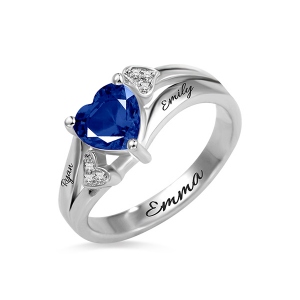The Birthstone of February - Amethyst
Amethyst, also known as fluorite fluoritum, is a
violet variant of crystal and is commonly used as gem. Its name comes from the
ancient Greek ἀ a- (“no”) and μέθυστος methustos (“drunk”). Believing that
amethyst would protect its owners from drunkenness, the ancient Greeks wore
amethyst and used it to make drinking vessels. It is a type of crystal, a
semi-precious gem, and a traditional birthstone custom friendship necklace for February.
The color of Amethyst
The main color of amethyst can be light violet to dark
purple. It may show one or both of the sub-tone of red and blue. The best
amethysts are produced in Siberia, Sri Lanka, Brazil and the Far East. The
ideal quality amethyst is called "Deep Siberian", which has a main
color of 75-80% purple and 15-20% of blue and (depending on lighting
conditions) a red sub-tone. Green crystal is sometimes mistakenly called green
amethyst, but in fact its mineralogical name should be Prasiolite.
 Amethyst usually has a long strip of ribbon parallel
to the surface of the crystal, which varies greatly in shades. In the art of
gem processing, there is a process that cuts the amethyst in a specific way,
which can make the finished gemstones appear the same color as a whole. The
purple tone best friend rings in
amethyst often appears only on the surface of the stone, or the color is
uneven, making it difficult to cut.
Amethyst usually has a long strip of ribbon parallel
to the surface of the crystal, which varies greatly in shades. In the art of
gem processing, there is a process that cuts the amethyst in a specific way,
which can make the finished gemstones appear the same color as a whole. The
purple tone best friend rings in
amethyst often appears only on the surface of the stone, or the color is
uneven, making it difficult to cut.
Amethyst was used as a gemstone by the ancient
Egyptians and was often used as an intaglio gemstone in ancient times. The
intaglio gem is called intaglio. Medieval European soldiers believed wearing
amethyst amulets in battle could heal wounds and have a calming effect.
Granular amethyst was found in the British Anglo-Saxon grave.
Until the 18th century, amethyst was one of the
traditional gems personalized necklaces (others include diamonds, sapphires, rubies and emeralds). However, since a
large number of amethyst veins were found in Brazil and other places, it has
lost most of its value. Collectors are pursuing the intensity of their colors
and include as much red fire as possible. Because amethyst is produced in a
larger crystal form, the weight of amethyst is not generally expressed in
carats, which distinguishes it from other gems whose value increases
exponentially with the number of carats. The most important factor determining
the value of amethyst promise rings for
her is its color density. The highest quality amethyst (called "Deep
Russian") is very rare, so its value is determined by the needs of
collectors. B
Amethyst birthstone is abundantly produced in the
state of Minas Gerais, Brazil, especially in the form of large geode holes in
volcanic rocks. Many hollow agates from southwestern Brazil and Uruguay contain
clusters of amethyst. The best quality amethysts in the world are produced in
large quantities in Artigas, Uruguay and nearby Rio Grande do Sul, Brazil.
Minas Gerais, Mato Grosso, Espirito Santo, Bahia and Ceará are Brazil's main
amethyst personalized name necklace producing
regions.
Amethyst is also produced in Korea. The world's
largest open-air amethyst vein is located in the town of Messau in Lower
Austria. Russia produces a large number of high-quality amethysts, especially
near Mrsinka in Yekaterinburg, appearing in the form of crystal clusters in
granite cavities. There are also many amethyst custom name necklace producing areas in southern India. Zambia in
southern Africa produces about 1,000 tons of amethyst each year, making it one
of the world's largest amethyst producers.
Amethyst is found in many parts of the United States,
including Arizona, Colorado, Texas, Pennsylvania, North Carolina, Maine,
Minnesota, Wisconsin and Michigan. There are many amethyst producing places in
Ontario and Nova Scotia of Canada, and the amethyst producing place in Thunder
Bay, Ontario is the largest in North America.



 $
$  Pound Sterling
Pound Sterling CA Dollar
CA Dollar AU Dollar
AU Dollar Euro
Euro NZ Dollar
NZ Dollar Malaysian Ringgit
Malaysian Ringgit Philippine Peso
Philippine Peso Singapore Dollar
Singapore Dollar South African
South African Danish Krona
Danish Krona Hong Kong Dollar
Hong Kong Dollar Indonesia Rupiah
Indonesia Rupiah Mexican Peso
Mexican Peso Norwegian Kroner
Norwegian Kroner Swedish Krona
Swedish Krona Swiss Franc
Swiss Franc UAE Dirham
UAE Dirham CzechKoruna
CzechKoruna Türk Lirası
Türk Lirası Indian Rupee
Indian Rupee Brazillain Real
Brazillain Real Japanese Yen
Japanese Yen







